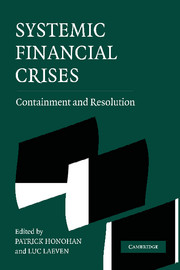Book contents
- Frontmatter
- Contents
- Contributors
- Foreword
- Acknowledgments
- PART ONE INTRODUCTION
- PART TWO CONTAINMENT AND RESOLUTION
- 2 Financial Crisis Policies and Resolution Mechanisms: A Taxonomy from Cross-Country Experience
- 3 Pitfalls in Managing Closures of Financial Institutions
- 4 Fiscal, Monetary, and Incentive Implications of Bank Recapitalization
- PART THREE MODELS AND ECONOMETRIC EVIDENCE
- PART FOUR STRUCTURAL REFORMS
- Appendix: Banking Crisis Database
- References
- Index
2 - Financial Crisis Policies and Resolution Mechanisms: A Taxonomy from Cross-Country Experience
Published online by Cambridge University Press: 24 August 2009
- Frontmatter
- Contents
- Contributors
- Foreword
- Acknowledgments
- PART ONE INTRODUCTION
- PART TWO CONTAINMENT AND RESOLUTION
- 2 Financial Crisis Policies and Resolution Mechanisms: A Taxonomy from Cross-Country Experience
- 3 Pitfalls in Managing Closures of Financial Institutions
- 4 Fiscal, Monetary, and Incentive Implications of Bank Recapitalization
- PART THREE MODELS AND ECONOMETRIC EVIDENCE
- PART FOUR STRUCTURAL REFORMS
- Appendix: Banking Crisis Database
- References
- Index
Summary
INTRODUCTION
As observed in recent years, systemic financial crises, especially those associated with a currency collapse, can be fast-moving events resulting in wealth destruction, crippling the financial system and magnifying economic decline. The channels of collapse are numerous. What starts as a moderate recession can become a steep decline in economic activity as financial losses generate large exchange rate movements and bank collapses. Exchange rate depreciation damages the net worth of those who have borrowed in foreign currency. Furthermore, a trend of depreciation raises nominal interest rates on loans, and also adversely affects the relative price movements for producers of nontradables. As borrowers' ability to repay declines, bank net worth is destroyed. Additional bank losses may result from banks' direct exposure to interest rate and exchange rate risk.
In the frictionless world of neoclassical economics, the distribution of wealth has no effect on the allocation of investment capital. But in the real world, the wealth of borrowers and banks plays an important allocative role in financial markets. Destruction of the net worth of borrowers, especially a fall in the value of real estate and other assets relied on for bank collateral, and of banks can cause a collapse of the loan market (Keynes 1931, Fisher 1933, and Bernanke 1983).
Declines in banks' net worth, which can result in bank failures, reduce or eliminate banks' abilities to supply loans.
- Type
- Chapter
- Information
- Systemic Financial CrisesContainment and Resolution, pp. 25 - 75Publisher: Cambridge University PressPrint publication year: 2005
- 20
- Cited by



